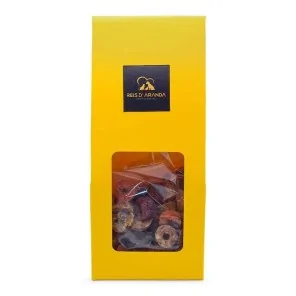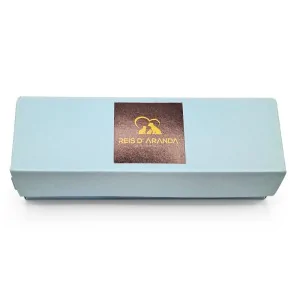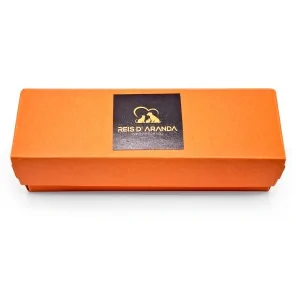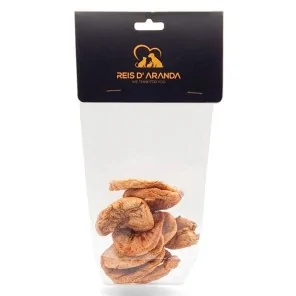The Tornjak originated from genetically homogeneous, almost extinct, indigenous shepherd dogs. These dogs have...
TYPES OF ENCLOSURES FOR RABBITS AND GUINEA PIGS
INTRODUCTION
When we open the doors of our home to a new bunny or guinea pig, the typical cage sold in the pet shop always comes to mind, but are there other options? Which is the best and which is the worst?
Some people prefer to adapt an entire room in the house or build them a wooden house in the garden, how can they be conditioned, and what can we clean them with that does not affect our pet?
WHAT TYPES OF HABITAT ARE AVAILABLE FOR RABBITS AND GUINEA PIGS?
When we think of having a rabbit or guinea pig, we always think of the typical: a cage with a plastic base and bars of about 60cm with a drinking bottle and a little wooden house that barely fits in it. But nowadays the world of rabbits and guinea pigs as pets has grown a lot in Spain (not as much as we would like, but in the last 15 years there have been great advances).
Nowadays we can find many options of enclosures in the market or through the social networks: styles, materials, complements, ideas...
What can we find?
- CAGES: Cages are a double-edged sword and have both people who call them ‘the safest way to keep our pets’ and detractors who say that they are animal abuse.
All of us in the pet world know that cages can be both positive and negative and that they are actually considered a safe place for our animals (as long as they are outside for as long as possible and are allowed to exercise), being essential if they are breeding animals.
We can find:
>>METALLIC COMMERCIAL CAGES: These are the ones focused on commercial breeding and animals destined for consumption (meat or fur) they are rather small in size and are made entirely of metal, the floor is made of bars (allowing urine and faeces to fall to the ground) and, from the administrative point of view (town halls) they are considered the most hygienic because they can be disinfected with fire. These types of cages are frowned upon by ethical breeders and their dimensions are standard.
>>COMMERCIAL PLASTIC CAGES: The ‘traditional’ cages, with a plastic base and metal bars on top, with a top or side door, they come in different sizes, shapes and colours.
>>CRAFT WOODEN CAGES: These are the ones used by the vast majority of ethical breeders, they are handmade and can have the shape, colour and size they choose, the door is always on the side and they have a plastic storage drawer inside to make cleaning easier. The walls, floor and ceiling are made of wood treated against humidity and fungus, as well as very resistant wood (the same as the kitchen furniture), the doors are usually made of chicken wire.

(IZQ: Commercial ‘meat’ cage || C: Commercial cage || DCH: Craftsman cages).
- PARKS: The parks are a perfect option for those people who cannot or do not want to keep their rabbit or guinea pig loose in the house but do not like the idea of it being locked up in a cage. It is another safe option and allows us to be more creative by being able to include toys, beds or castles that they can climb inside.
>>METALLIC PARKS: These are mainly used for dogs, they are resistant, can be used outdoors and indoors and are usually of considerable height. They are usually all black.
>>PLASTIC PANEL PARKS: They can be assembled as you wish, they can only be used indoors and there are both translucent and transparent; they are purchased in batches of panels so we can make them as big and as high as we want.
>>FABRIC PARKS: They are usually recommended for very young rabbits, weigh very little and are available in many designs and bright colours.

(LEFT: Metal playpen || C: Panel playpen || RIGHT: Cloth playpen)
- CONDITIONED ROOMS: Some people adapt the rooms in their house or build little houses in the garden for their rabbits and guinea pigs to live in ‘freedom’, this is a much more modern option but requires a lot of space.
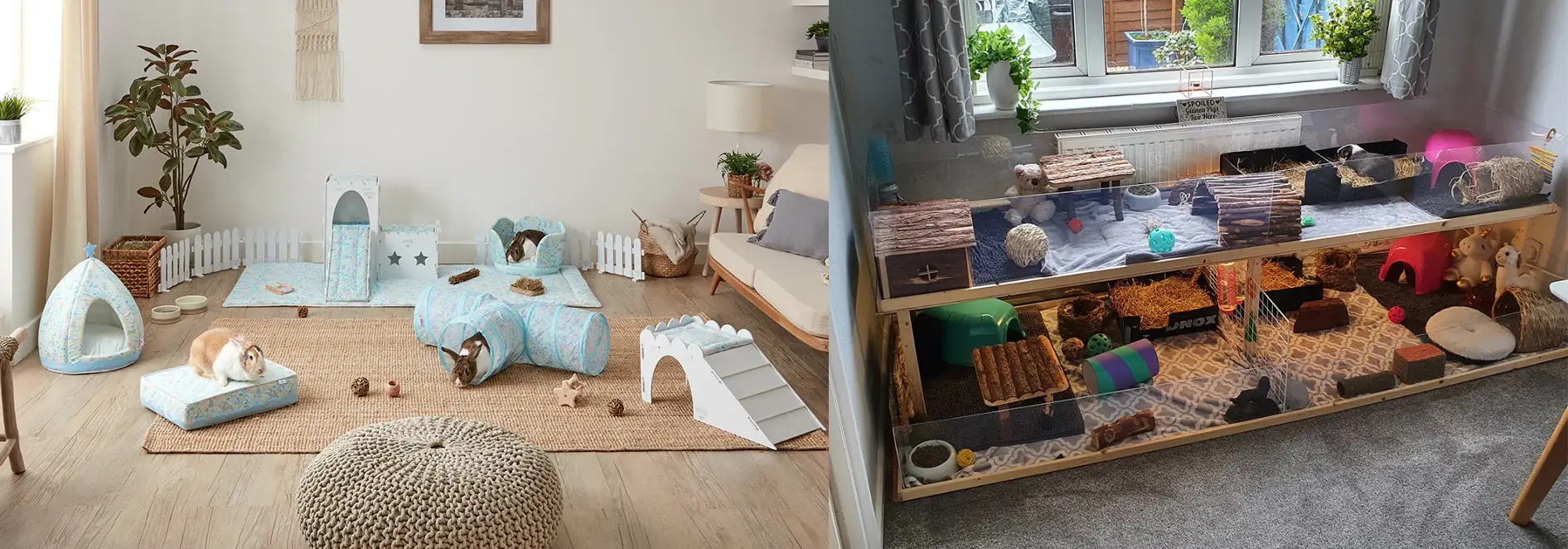
(ABOVE: Rooms set up for rabbits and guinea pigs)
PROS AND CONS OF EACH TYPE OF HABITAT
As with everything in life, each of the options we have looked at has its pros and cons:
- METALLIC COMMERCIAL CAGES: They can be disinfected with fire and cleaning is much more comfortable and quicker as all the waste falls to the floor (urine and faeces), they have a standard size which can be quite small (especially in the case of rabbits with young) and it is necessary to put what is called a ‘foot-saver’ (a piece of perforated plastic) so that the animal can be placed on top and thus prevent the appearance of pododermatitis.
- COMMERCIAL PLASTIC CAGES: These are expensive products for the quality they offer. It is common for rabbits to bite the sides of the plastic base or the hooks and end up breaking them. As they become damaged, cleaning becomes more complicated; one good thing is that they can be easily dismantled and stored, and they are quite light.
- CRAFT WOODEN CAGES: They are very easy to clean with cleaning products without bleach, in the event that the plastic base is damaged over time by urine it can be easily replaced (the bases are quite cheap) and are made according to the space available, something against is that they are heavy items (being made of good wood) and expensive.
- METALLIC PARKS: They do not rust easily and they cannot damage it by biting the bars (which are wide and do not fit in their mouths, unlike those of the cages), they are expensive but worth it.
- PLASTIC PANEL PARKS: These are expensive and weightless products, so it is easy to move them if you trip over them (unlike the metal parks), they are fun and allow you to be creative when assembling them.
- FABRIC PARKS: These are recommended for very young rabbits or guinea pigs but are not at all recommended (apart from the fact that they can be folded and stored easily), they cannot be cleaned properly and are extremely easy to break when chewed.
- AIR CONDITIONED ROOMS: The animal has much more freedom and, as there is more space, cleaning is usually easier as it is possible to install several litter trays. It is necessary to have a large house with several rooms to be able to set up one especially for them.
HOW DO I CLEAN MY RABBIT OR GUINEA PIG'S HABITAT?
The type of cleaning will always depend on how clean or dirty our pet is and the type of habitat it has, but for this we will always use cleaning products without bleach (such as ‘Bosque Verde’ or ‘Sanytol’) especially in hot weather as it is easier for flies to proliferate and myiasis can occur due to poor hygiene. Cleaning should be done every two days or, at the latest, once a week.
CONCLUSION
The type of habitat we offer our pet will always depend on our economic possibilities and the space we have, but we should never opt for the cheapest or smallest option as it will end up breaking or becoming useless as our pet grows and we will be forced to spend more money. It is essential that we use the best possible materials, the most hygienic and coolest ones that allow correct ventilation and temperature, and if these are compromised (ventilation and temperature) the best investment we can make is to buy a portable air conditioner.
Leave a comment
Log in to post comments

